English Silver Hallmarking
English Silver Hallmarking
Hi,
Although I registered about four years ago, this is my first post.
I have a question about English Silver Hallmarking, I hope this makes sense.
Was it ok in the second half of the 19th century for English silversmiths to send an item for assaying, and request it to be hallmarked for the following year, was the silversmith allowed to do that, or do you think the assay office would insist on the item being hallmarked for the current year.
I understand this seems like an odd question, but it relates to an item in my silver collection.
Thanks,
Dave
Although I registered about four years ago, this is my first post.
I have a question about English Silver Hallmarking, I hope this makes sense.
Was it ok in the second half of the 19th century for English silversmiths to send an item for assaying, and request it to be hallmarked for the following year, was the silversmith allowed to do that, or do you think the assay office would insist on the item being hallmarked for the current year.
I understand this seems like an odd question, but it relates to an item in my silver collection.
Thanks,
Dave
-
silvermakersmarks
- co-admin
- Posts: 1803
- Joined: Tue Apr 09, 2013 9:22 am
- Location: Hertfordshire, UK
- Contact:
Re: English Silver Hallmarking
An interesting question for a first post! This may be one of those questions the answer to which is "Nobody knows".
To do as you suggest would mean holding on to the piece until the following year's date letter punch had been made and was available for use. I can't see that it would have been acceptable to pre-stamp items; indeed in some of the smaller assay offices the new punches may not even have been ordered until after the start of the assay year.
You do not say exactly what about the item in your collection prompted the question but I wonder if it can be answered by the fact that the date letters - for all assay offices - changed during the year and not at the start of the calendar year.
Phil
To do as you suggest would mean holding on to the piece until the following year's date letter punch had been made and was available for use. I can't see that it would have been acceptable to pre-stamp items; indeed in some of the smaller assay offices the new punches may not even have been ordered until after the start of the assay year.
You do not say exactly what about the item in your collection prompted the question but I wonder if it can be answered by the fact that the date letters - for all assay offices - changed during the year and not at the start of the calendar year.
Phil
Re: English Silver Hallmarking
Hi Dave, welcome to the forum. Why not show us an image of all the marks of the silver item in question ?
For more information about UK assay office year letter change see:
https://www.silvermakersmarks.co.uk/Dates/London.html
Peter.
For more information about UK assay office year letter change see:
https://www.silvermakersmarks.co.uk/Dates/London.html
Peter.
Re: English Silver Hallmarking
Phil and Peter,
Many thanks for your replies.
Firstly, I am happy to post images of the item including the hallmarks, I just need to photograph them.
Phil has brought up an interesting point, that some assay offices may not have run there marking years from January to December, I had not thought of that, I just assumed that is what they all did.
As I am new to this forum, do I start a new thread in the appropriate area with more info and the images of my item, as this is just for general questions.
Dave
Many thanks for your replies.
Firstly, I am happy to post images of the item including the hallmarks, I just need to photograph them.
Phil has brought up an interesting point, that some assay offices may not have run there marking years from January to December, I had not thought of that, I just assumed that is what they all did.
As I am new to this forum, do I start a new thread in the appropriate area with more info and the images of my item, as this is just for general questions.
Dave
-
silvermakersmarks
- co-admin
- Posts: 1803
- Joined: Tue Apr 09, 2013 9:22 am
- Location: Hertfordshire, UK
- Contact:
Re: English Silver Hallmarking
Just add your pictures to this thread, Dave. It can then be moved as appropriate.
The link to my site which Peter posted above gives details of London date letter changes. The other assay offices changed on different dates. Date letters have only changed on 1st January since 1975.
Phil
The link to my site which Peter posted above gives details of London date letter changes. The other assay offices changed on different dates. Date letters have only changed on 1st January since 1975.
Phil
Re: English Silver Hallmarking
Hi Dave,
Welcome to the Forum.
Trev.
Welcome to the Forum.
Definitely not. Great ceremony is placed on the changing of the date letters. In the case of London at this time, and up to 1974, on the 29th May, or as near as possible (the day being connected with St. Dunstan's Day, the patron saint of goldsmiths, and the traditional day that new Wardens were installed, followed by a service at St. Paul's and a feast at Goldsmiths' Hall ), the old punches are ground down in front of witnesses, and the new punches issued. This was the case since 1696, but as Phil has already stated, all UK offices have moved their date letter changes to the 1st January as from 1975, following the Hallmarking Act of 1973.Was it ok in the second half of the 19th century for English silversmiths to send an item for assaying, and request it to be hallmarked for the following year, was the silversmith allowed to do that, or do you think the assay office would insist on the item being hallmarked for the current year.
Trev.
Re: English Silver Hallmarking
Hi All,
Please could you move this to the correct forum.
As promised here is the silver item I have and was asking about assay office hallmarking. This three handled cup is marked for Henry Wigfull in Sheffield in 1881. It is a large cup, standing 19cm high by 17.5cm wide. I purchased the item from an auction house in Melbourne, Australia when I was over there on a business trip three years ago. In the last week or so, I decided to do a little research into the cup, and discovered that it was on display at the Melbourne International Exhibition that ran from 1880 to 1881, and Henry Wigfull had won a prize for his exhibits.
I found a newspaper article in the Sydney Morning Herald for October 1880, where it mentions this cup, see image below. So, the reasons for the first question was, if the cup is hallmarked for 1881, it was clearly in Melbourne from October 1880, and I assume remained in Australia, until I purchased it in 2016. Out of interest, is it possible to find out what date the Sheffield assay office changes its hallmarking punches from one year to the next in the 1880's.
Hope you like the item as much as I do.
Dave
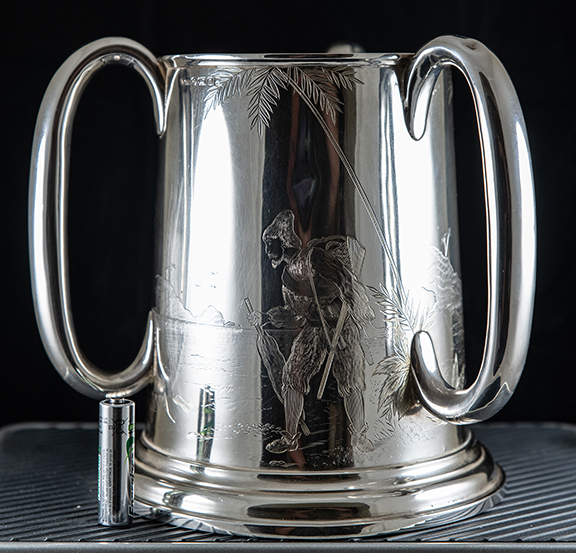
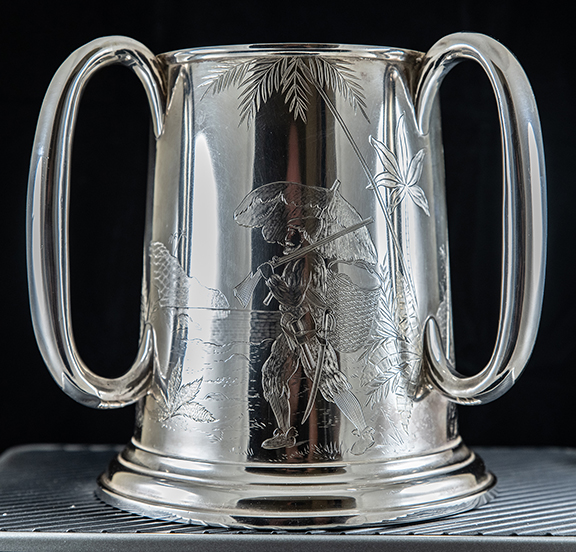
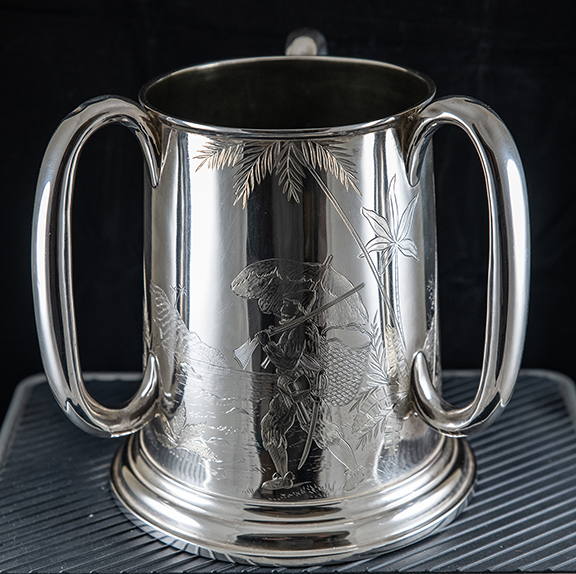
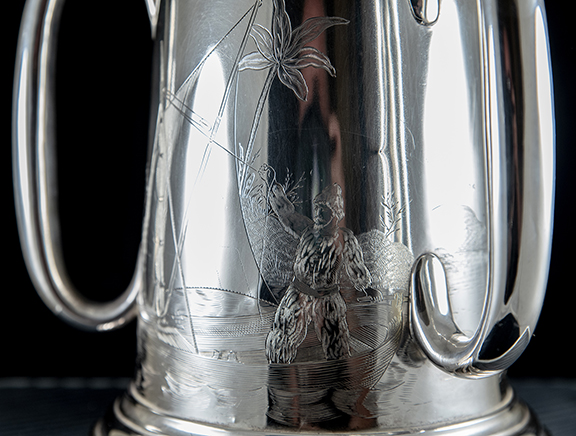
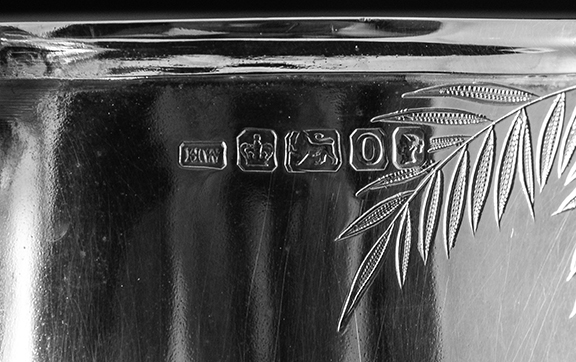
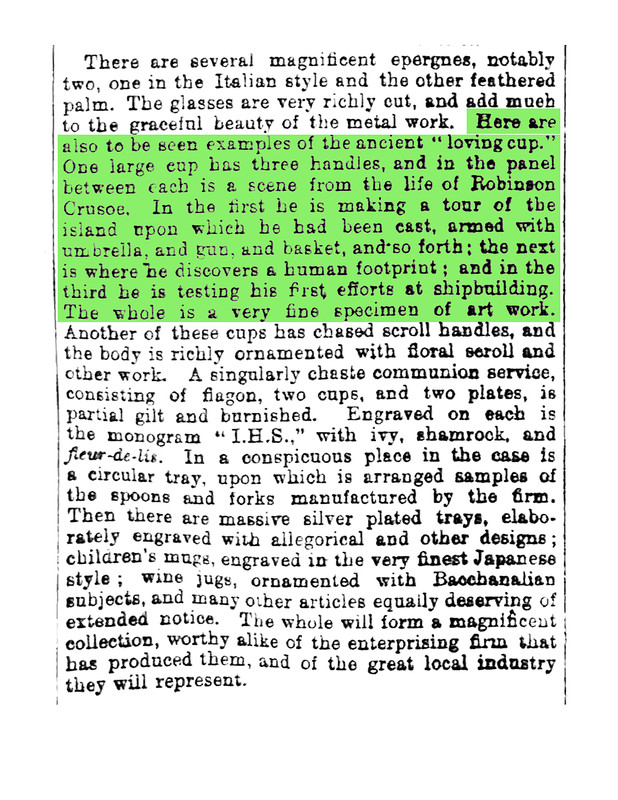
Please could you move this to the correct forum.
As promised here is the silver item I have and was asking about assay office hallmarking. This three handled cup is marked for Henry Wigfull in Sheffield in 1881. It is a large cup, standing 19cm high by 17.5cm wide. I purchased the item from an auction house in Melbourne, Australia when I was over there on a business trip three years ago. In the last week or so, I decided to do a little research into the cup, and discovered that it was on display at the Melbourne International Exhibition that ran from 1880 to 1881, and Henry Wigfull had won a prize for his exhibits.
I found a newspaper article in the Sydney Morning Herald for October 1880, where it mentions this cup, see image below. So, the reasons for the first question was, if the cup is hallmarked for 1881, it was clearly in Melbourne from October 1880, and I assume remained in Australia, until I purchased it in 2016. Out of interest, is it possible to find out what date the Sheffield assay office changes its hallmarking punches from one year to the next in the 1880's.
Hope you like the item as much as I do.
Dave






Re: English Silver Hallmarking
Hi Dave,
I fear I'm going to disappoint you greatly.
Exhibitions, such as the one held at Melbourne, were held for the purpose of trade, the items on display were there not only to to show the skills and wares of the exhibitors, but also to take orders of the items shown. Lee & Wigfull, the makers of your excellent cup, were a very large Sheffield firm with showrooms in Sheffield and London, probably employing dozens of silversmiths, buffers, polishers, engravers, chasers, etc., they would have gone to Melbourne with the intention of making a profit.


The fact your cup is hallmarked for 1881-82, and that your item was found in Australia, shows the likelihood they probably took quite a few orders for them at the exhibition.
I'm sorry that my thoughts are probably the last thing you wanted to hear.
Trev.
I fear I'm going to disappoint you greatly.
Exhibitions, such as the one held at Melbourne, were held for the purpose of trade, the items on display were there not only to to show the skills and wares of the exhibitors, but also to take orders of the items shown. Lee & Wigfull, the makers of your excellent cup, were a very large Sheffield firm with showrooms in Sheffield and London, probably employing dozens of silversmiths, buffers, polishers, engravers, chasers, etc., they would have gone to Melbourne with the intention of making a profit.


The fact your cup is hallmarked for 1881-82, and that your item was found in Australia, shows the likelihood they probably took quite a few orders for them at the exhibition.
I'm sorry that my thoughts are probably the last thing you wanted to hear.
Trev.
Re: English Silver Hallmarking
Perhaps more copies of this three handled cup were made in the UK and sold during the exhibition period in Melbourne, opening 1 october1880, closure 30 April 1881 and perhaps still after the end of the exhibition.
Peter.
Peter.
Re: English Silver Hallmarking
Trevor and Peter,
Thanks for the replies.
You may well be right, that more were made if orders were taken, but we simply do not know that at this stage. I search a lot of auctions worldwide every day, and I have not seen another, that is not to say that others do not exist. Do we know if there are Lee & Wigfull records in existence, that might record this cup design being reproduced. Would the Sheffield assay office have records perhaps, although that might not describe the item or items that were sent for hallmarking.
Unless I can do some further research, my item could be the one described in the exhibition.
Dave
Thanks for the replies.
You may well be right, that more were made if orders were taken, but we simply do not know that at this stage. I search a lot of auctions worldwide every day, and I have not seen another, that is not to say that others do not exist. Do we know if there are Lee & Wigfull records in existence, that might record this cup design being reproduced. Would the Sheffield assay office have records perhaps, although that might not describe the item or items that were sent for hallmarking.
Unless I can do some further research, my item could be the one described in the exhibition.
Dave
-
silvermakersmarks
- co-admin
- Posts: 1803
- Joined: Tue Apr 09, 2013 9:22 am
- Location: Hertfordshire, UK
- Contact:
Re: English Silver Hallmarking
Sheffield date letters changed on the first Monday in July when the Wardens for the following year were elected. We can therefore say that your cup was assayed in Sheffield between Monday 4th July 1881 and Saturday 1st Jul 1882. It can not possibly have been in Melbourne during the exhibition period so must have been made to order and shipped out to Australia after the exhibition closed.
Phil
Phil